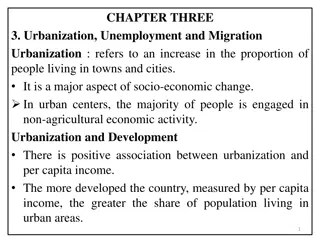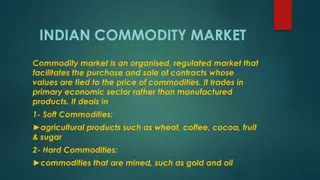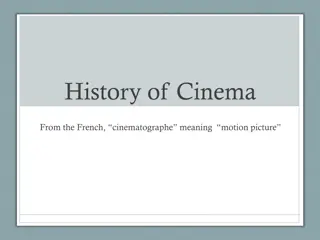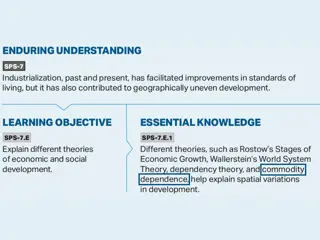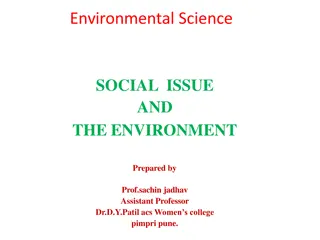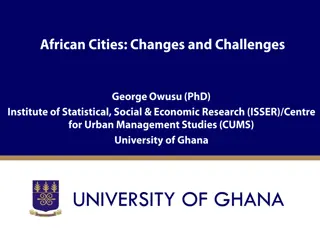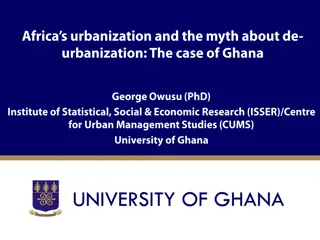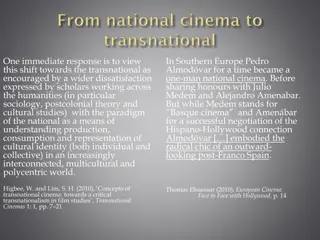Exploring Commodity Frontiers and Urbanization in Brazilian Cinema and Literature
The texts "Inferno" by Patricia Melo and "City of God" directed by Fernando Meirelles and Kátia Lund depict the shaping of Rio's history by commodity frontier movements in Brazil. These movements include the migration of people to cities due to agricultural crises, emergence of drug trade, particularly cocaine, and the development of favelas. The portrayal of favelas in Brazilian cinema since the 1950s reflects various perspectives on urbanization. The narratives also highlight the marginalized urban populations and their struggles for survival in a capitalist society.
Download Presentation

Please find below an Image/Link to download the presentation.
The content on the website is provided AS IS for your information and personal use only. It may not be sold, licensed, or shared on other websites without obtaining consent from the author. Download presentation by click this link. If you encounter any issues during the download, it is possible that the publisher has removed the file from their server.
E N D
Presentation Transcript
Patricia Melo, Inferno (2000) Fernando Meirelles and K tia Lund (dirs.), City of God (2002)
Why study these texts? What have they to do with commodity frontiers? shaping of the history of Rio by commodity frontier movements in Brazil movement of people to the city as a result of agricultural crises / agro-industrialization drugs, cocaine particularly here, as a commodity frontier
Rios favelas begin to develop in the late 19th century Alu sio Azevedo s O Corti o [The Slum] (1890) represents one of their first literary treatments he concentrated on very precise descriptions of collective scenes and psychologically primary types that transform, as a whole, the tenement into the most convincing character of our Naturalist novels. (Alfredo Bosi)
The favelas on film: Since the mid 1950s, with Nelson Pereira dos Santos s Rio 40 Graus [Rio 40 Degrees], the favelas have been present in modern Brazilian cinema. Sometimes they are broached as setting, at other times as theme. However, during the 1960s, especially with Cinema Novo the movement that renewed Brazilian film production by dealing with national themes from a critical perspective and experimenting with unique forms and aesthetics favelas were treated as one of the more perverse images of Brazilian urbanization (M rcia Pereira Leite, in City of God in Several Voices, p. 149)
https://www.youtube.com/watch?v=mutKYwMc-Jg&t=261s https://www.youtube.com/watch?v=JTcisAwgMM8
Wasted lives, surplus humanity: This outcast proletariat perhaps 1.5 billion people today, 2.5 billion by 2030 is the fastest growing and most novel social class on the planet. By and large, the urban informal working class is not a labour reserve army in the nineteenth- century sense: a backlog of strikebreakers during booms; to be expelled during busts; then reabsorbed again in the next expansion. On the contrary, this is a mass of humanity structurally and biologically redundant to global accumulation and the corporate matrix (Mike Davis, Planet of Slums, p. 11). Without access to employment and wages, these surplus populations are left without the means to access subsistence, and many end up trying to survive through the black market or trash pick. The formation and growth of this kind of permanent surplus population can also be theorized as a kind of disposability and throwing away within capitalism. Once relegated as permanent surplus, meaning that capital no longer needs these populations as labour, these populations are little more than the human-as-waste, excreted from the capitalist system Yates, Michelle Yates, "The Human As Waste, the Labor Theory of Value and Disposability in Contemporary Capitalism." Antipode 43.5 (2011): 1680.
Every commodity frontier is also a waste frontier (Jason Moore, The Capitalocene, Part II). New primary production regimes, until now, could develop much faster than did waste-induced costs. Outrunning these contradictions was possible because there were geographical frontiers not just continents, but bodily, subterranean, and atmospheric spaces from which free gifts could be extracted, and into which free garbage could be deposited. (Moore, Capitalism in the Web of Life)
Boca de lixo (Eduardo Coutinho, 1992) The Scavengers recognizes the importance of media images for even impoverished people, who own television sets and are aware of the offensive way in which they are typically portrayed. At the beginning of the film, the crew approaches people who hide their faces and wave the camera away, mirroring the discomfort of the viewer, who is con fronted with those caught in degrading and precarious circumstances. https://www.youtube.com/watch ?v=UY-4w-JQkOw
The neoliberal regime of accumulation: Neoliberalism names a specific regime of accumulation within capitalism, one that emerges in the early 1970s in the context of a global economic downturn. Neoliberalism as an ecological regime as a particular way of organizing nature in the interests of expanded accumulation Neoliberalism seeks to secure new supplies of cheap nature food, energy, raw materials, labour-power in order to drive down the costs of production
What distinguishes the neoliberal ecological regime? Lack of a productivity revolution capable of instigating a new, system-wide long wave of accumulation Previous crisis resolved through a dialectic of productivity and plunder: the reorganization of paid work in tandem with the appropriation of vast streams of unpaid work Scientific-technological revolution capable of boosting labour productivity has been absent decline in the growth of annual labour productivity in the OECD from 4.6% in 1960-73 to 1.6% in 1979-97
Neoliberalism instead has relied on an extractive strategy that discouraged long-term investments by states and capitals, and encouraged socio-ecological asset-stripping of every sort pension funds were raided, state enterprises privatized, water and energy sources depleted (Moore, Cheap Food and Bad Money (2012): 231) succeeded in reviving accumulation only by cannibalizing the accomplishments of the Fordist-Keynsian order Capital has confronted difficulties in securing new streams of unpaid work, while exhausting (overexploiting and commodifying) those cheap natures that had been created
modernitys epoch-making reorganizations of labor and land were premised on ruthless conquest and the ongoing appropriation of wealth on the frontier. The frontier of what? Of commodification and global value relations. For central to the great arc of modern world history has been the voracious consumption of, and relentless quest for, Cheap Natures cheap in relation to the accumulation of capital and its curious privileging of wage-work as the only thing worth valuing. A civilizational conceit of this sort could only emerge on the basis of devaluing both human work outside the commodity system much of it so-called women s work and the work of extra-human natures. Moore, Capitalism in the Web of Life
The end of Cheap Nature? Key sources of unpaid work: women, nature, and the colonies Climate change paying for the atmosphere? Yield suppression? The barriers to a new agricultural revolution are [. . .] extraordinary. [. . .] The list of prominent biophysical challenges surely begins with climate change, which is already suppressing work/energy potential. The UN sees an absolute decline in net primary productivity for 12 percent of the planet184 by 2050, but the problem is even more immediate. While global NPP increased between 1982 and 1999 was this merely coincident with the neoliberal golden age? it declined between 2000 and 2009. With global impacts concentrated in the South (Indonesia s NPP declined nearly 20 percent), the decade was punctuated by a series of severe droughts.186 These have continued, with Russia s in 2010 followed by severe drought in the North China Plain in 2010 11, and in North America in 2012. (Moore, Capitalism in the Web of Life
Global top soil erosion: soil is being eroded at a rate of up to 100 times greater than it can be naturally replenished
the crisis of care The crisis of care refers to the pressures from several directions that are currently squeezing a key set of social capacities: those available for birthing and raising children, caring for friends and family members, maintaining households and broader communities, and sustaining connections more generally. Historically, these processes of social reproduction have been cast as women s work, although men have always done some of it too. Comprising both affective and material labour, and often performed without pay, it is indispensable to society. Without it there could be no culture, no economy, no political organization. No society that systematically undermines social reproduction can endure for long. Today, however, a new form of capitalist society is doing just that. The result is a major crisis, not simply of care, but of social reproduction in this broader sense. the more or less acute expression of the social-reproductive contradictions of financialized capitalism (Nancy Fraser, Contradictions of Capital and Care, New Left Review, 100, 2016: 99).
The end of the frontier? Until now, participants in the depletion of a particular resource zone could always comfort themselves with the thought that undeveloped lands lie somewhere else, still awaiting human exploitation. [. . .] The giant oil and mining companies have continuously extended their spheres of operation from traditional sites in Europe, North America, and Russia to remote and forbidding regions of Africa, Asia, and Latin America. Today, however, there exist no untilled lands or untapped oil reserves awaiting fresh development. Virtually all accessible resource zones are now in production; except for the extreme areas such as the Arctic, the Congo, the ocean bottom, and unyielding rock formations, there is nowhere else to go. For this reason, the invasion of the world s final frontiers has unique significance. What we expropriate from these areas represents all that remains of the planet s once abundant resource bounty. In all likelihood, we are looking at the last oil fields, the last uranium deposits, the last copper mines, and the last reserves of many other vital resources. These materials will not all disappear at once, of course, and some as-yet-undeveloped reserves may prove more prolific than expected. Gradually, though, we will see the complete disappearance of many key resources upon which modern industrial civilization has long relied. (Michael Klare, The Race for What s Left,pp. 16-17)
There are limits to how much new work capitalism can squeeze out of new working classes, forests, aquifers, oilfields, coal seams, and everything else. Nature is finite. Capital is premised on the infinite. And both are historical in a very specific sense: what worked at one historical juncture will not necessarily work at the next. Thus the centrality of the Great Frontier in the history of capitalism, and the centrality of the end of the last frontiers Cheap oil in the Middle East, Cheap labor-power in China, Cheap food everywhere in the present conjuncture. It was this Great Frontier that inaugurated a civilizational metabolism in which most nature, including most humans, was sacrificed in service to the productivity of wage-labor. These frontiers of appropriation were the major way of making others, outside the circuit of capital but within reach of capitalist power, foot the bill for endless accumulation. The great secret and the great accomplishment of capitalist civilization has been to not pay its bills. Frontiers made that possible. Their closure is the end of Cheap Nature and with it, the end of capitalism s free ride. (Moore)








